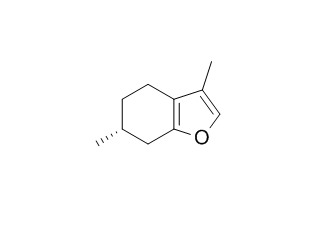(+)-Menthofuran
(+)-Menthofuran shows human CYP2A enzymes inhibitory.
Inquire / Order:
manager@chemfaces.com
Technical Inquiries:
service@chemfaces.com
Tel:
+86-27-84237783
Fax:
+86-27-84254680
Address:
1 Building, No. 83, CheCheng Rd., Wuhan Economic and Technological Development Zone, Wuhan, Hubei 430056, PRC
Providing storage is as stated on the product vial and the vial is kept tightly sealed, the product can be stored for up to
24 months(2-8C).
Wherever possible, you should prepare and use solutions on the same day. However, if you need to make up stock solutions in advance, we recommend that you store the solution as aliquots in tightly sealed vials at -20C. Generally, these will be useable for up to two weeks. Before use, and prior to opening the vial we recommend that you allow your product to equilibrate to room temperature for at least 1 hour.
Need more advice on solubility, usage and handling? Please email to: service@chemfaces.com
The packaging of the product may have turned upside down during transportation, resulting in the natural compounds adhering to the neck or cap of the vial. take the vial out of its packaging and gently shake to let the compounds fall to the bottom of the vial. for liquid products, centrifuge at 200-500 RPM to gather the liquid at the bottom of the vial. try to avoid loss or contamination during handling.
Anal Sci.2019, 35(12):1317-1325
PLoS One.2018, 13(11):e0208055
J Pharm Biomed Anal2016, 118:183-194
Sci Rep.2021, 11(1):14180.
Fitoterapia.2024, 177:106138.
Fitoterapia.2015, 100:179-86
Industrial Crops and Products2019, 140:111612
Int J Biol Macromol.2019, 126:653-661
Int J Oncol.2019, 55(1):320-330
Separations2023, 10(2), 131.
Related and Featured Products
Drug Metabolism and Disposition, September 2012, 40 (9) 1797-1802.
Evaluation of Inhibition Selectivity for Human Cytochrome P450 2A Enzymes.[Reference:
WebLink]
Cytochrome P450 (P450) enzymes are mixed-function oxidases that catalyze the metabolism of xenobiotics and endogenous biochemicals. Selective inhibitors are needed to accurately distinguish the contributions of individual P450 enzymes in the metabolism of drugs and the activation of procarcinogens in human tissues, but very frequently these enzymes have substantial overlapping selectivity.
METHODS AND RESULTS:
We evaluated a chemically diverse set of nine previously identified CYP2A6 inhibitors to determine which are able to discriminate between human CYP2A enzymes CYP2A6 and the 94%-identical CYP2A13 enzyme. Inhibitor binding to recombinant purified enzyme was evaluated, and affinities were determined. Ki values were determined for inhibition of p-nitrophenol 2-hydroxylation, a reaction accomplished by CYP2A13 and CYP2A6 with more similar catalytic efficiencies (kcat/Km 0.19 and 0.12 μM−1 · min−1, respectively) than hydroxylation of the classic substrate coumarin (0.11 and 0.53 μM−1 · min−1, respectively). Of the nine compounds assayed, only tranylcypromine and (R)-(+)-Menthofuran had a greater than 10-fold preference for CYP2A6 inhibition versus CYP2A13 inhibition. Most compounds evaluated [tryptamine, 4-dimethylaminobenzaldehyde, phenethyl isothiocyanate, β-nicotyrine, (S)-nicotine, and pilocarpine] demonstrated only moderate or no preference for inhibition of one CYP2A enzyme over the other. However, 8-methoxypsoralen has a 6-fold lower Ki for CYP2A13 than for CYP2A6.
CONCLUSIONS:
This information is useful to inform reinterpretation of previous data with these inhibitors and to guide future studies seeking to determine which human CYP2A enzyme is responsible for the in vivo metabolism of compounds in human tissues expressing both enzymes.
Proceedings of the National Academy of Sciences of the United States of America, 17 Nov 2003, 100(24):14481-14486.
Menthofuran regulates essential oil biosynthesis in peppermint by controlling a downstream monoterpene reductase.[Reference:
WebLink]
(+)-Pulegone is a central intermediate in the biosynthesis of (-)-menthol, the most significant component of peppermint essential oil. Depending on environmental conditions, this branch point metabolite may be reduced to (-)-menthone en route to menthol, by pulegone reductase (PR), or oxidized to (+)-Menthofuran, by menthofuran synthase (MFS).
METHODS AND RESULTS:
To elucidate regulation of pulegone metabolism, we modified the expression of mfs under control of the CaMV 35S promoter in transformed peppermint plants. Overexpression and cosuppression of mfs resulted in the respective increase or decrease in the production of menthofuran, indicating that the control of MFS resides primarily at the level of transcription. Significantly, in both WT peppermint as well as in all transformed plants, the flux of (+)-pulegone through PR correlated negatively with the essential oil content of menthofuran, such that menthofuran, and pulegone increased, or decreased, in concert. These results suggested that menthofuran itself might influence the reduction of pulegone. Although (+)-Menthofuran did not inhibit (+)-PR activity, stem feeding with menthofuran selectively decreased pr transcript levels in immature leaves, thereby accounting for decreased reductase activity and increased pulegone content.
CONCLUSIONS:
These data demonstrate that the metabolic fate of (+)-pulegone is controlled through transcriptional regulation of mfs and that menthofuran, either directly or indirectly, influences this process by down-regulating transcription from pr and/or decreasing pr message stability. The ability to reduce both menthofuran and pulegone levels is of commercial significance in improving essential oil quality; however, the physiological rationale for such complex regulation is presently unclear.



